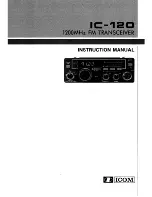
90
Surround
The AVR-2805/985 is equipped with a digital signal processing circuit that lets you play program sources in the surround mode to achieve the same
sense of presence as in a movie theater.
Dolby Surround
(1) Dolby Digital
Dolby Digital is the multi-channel digital signal format developed by Dolby Laboratories.
Dolby Digital consists of up to “5.1” channels - front left, front right, center, surround left, surround right, and an additional channel exclusively
reserved for additional deep bass sound effects (the Low Frequency Effects – LFE – channel, also called the “.1” channel, containing bass
frequencies of up to 120 Hz).
Unlike the analog Dolby Pro Logic format, Dolby Digital’s main channels can all contain full range sound information, from the lowest bass, up
to the highest frequencies – 22 kHz. The signals within each channel are distinct from the others, allowing pinpoint sound imaging, and Dolby
Digital offers tremendous dynamic range from the most powerful sound effects to the quietest, softest sounds, free from noise and distortion.
2
Dolby Digital and Dolby Pro Logic
Comparison of home surround systems
Dolby Digital
Dolby Pro Logic
No. recorded channels (elements)
5.1 ch
2 ch
No. playback channels
5.1 ch
4 ch
Playback channels (max.)
L, R, C, SL, SR, SW
L, R, C, S (SW - recommended)
Audio processing
Digital discrete processing
Dolby Digital encoding/decoding
Analog matrix processing Dolby Surround
High frequency playback limit of surround
channel
20 kHz
7 kHz
2
Dolby Digital compatible media and playback methods
Marks indicating Dolby Digital compatibility:
.
The following are general examples. Also refer to the player’s operating instructions.
LD (VDP)
Coaxial Dolby Digital RF output jack
1
Set the input mode to “AUTO”.
(Page 59)
DVD
Optical or coaxial digital output
(same as for PCM)
2
Set the input mode to “AUTO”.
(Page 59)
Others
(satellite broadcasts, CATV, etc.)
Optical or coaxial digital output
(same as for PCM)
Set the input mode to “AUTO”.
(Page 59)
Media
Dolby Digital output jacks
Playback method (reference page)
1 Please use a commercially available adapter when connecting the Dolby Digital RF output jack of the LD player to the digital input jack.
Please refer to the instruction manual of the adapter when making connection.
2 Some DVD digital outputs have the function of switching the Dolby Digital signal output method between “bit stream” and “(convert to)
PCM”. When playing in Dolby Digital surround on the AVR-2805/985, switch the DVD player’s output mode to “bit stream”. In some cases
players are equipped with both “bit PCM” and “PCM only” digital outputs. In this case connect the “bit PCM” jacks
to the AVR-2805/985.
(2)
Dolby Pro Logic
II
x
•
Dolby Pro Logic
II
x furthers the matrix decoding technology of Dolby Pro Logic
II
to decode audio signals recorded on two
channels into up to 7.1 playback channels, including the surround back channel. Dolby Pro Logic
II
x also allows 5.1-channel
sources to be played in up to 7.1 channels.
The mode can be selected according to the source. The Music mode is best suited for playing music, the Cinema mode for
playing movies, and the Game mode for playing games. The Game mode can only be used with 2-channel audio sources.
(3) Dolby Pro Logic
II
• Dolby Pro Logic
II
is a new multi-channel playback format developed by Dolby Laboratories using feedback logic steering technology and
offering improvements over conventional Dolby Pro Logic circuits.
• Dolby Pro Logic
II
can be used to decode not only sources recorded in Dolby Surround (
) but also regular stereo sources into five channels
(front left, front right, center, surround left and surround right) to achieve surround sound.
• Whereas with conventional Dolby Pro Logic the surround channel playback frequency band was limited, Dolby Pro Logic
II
offers a wider
band range (20 Hz to 20 kHz or greater). In addition, the surround channels were monaural (the surround left and right channels were the
same) with previous Dolby Pro Logic, but Dolby Pro Logic
II
they are played as stereo signals.
• Various parameters can be set according to the type of source and the contents, so it is possible to achieve optimum decoding (see page
71).











































